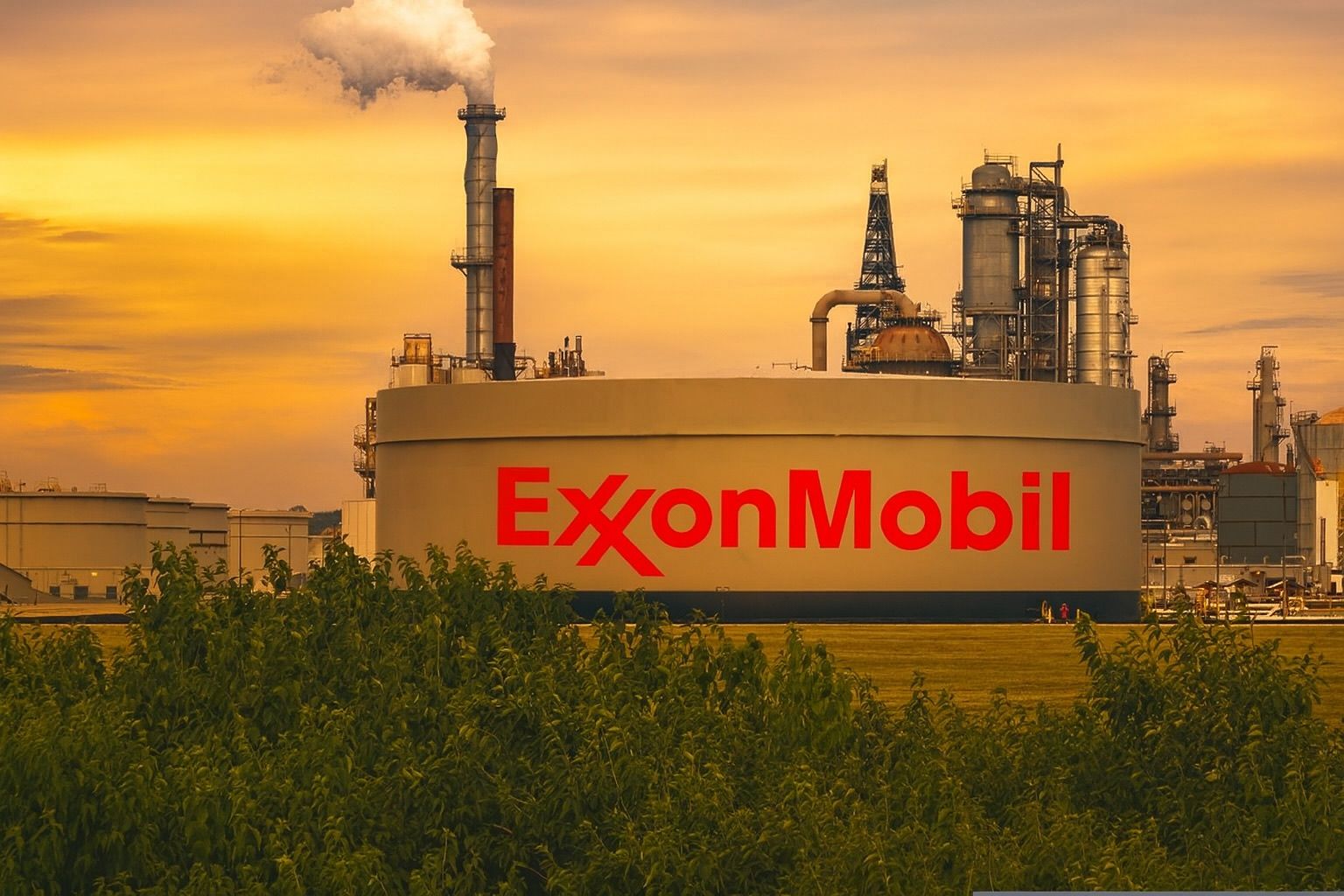- Price & Performance: XOM closed around $114.6 on Oct. 30, 2025 [1] (in a $97.8–$123.2 52-week range [2]). It has trended modestly higher (+1–2%) over 6–12 months [3]. In premarket trading Oct. 31 it was near ~$112.7 (–1.6%) [4]. The stock trades with a dividend yield ~3.5% on its $4.12 annual payout.
- Recent News: In the past week Exxon reported Q3 2025 results, beat profit forecasts, but slightly missed revenue targets [5]. It announced a 4% increase in the quarterly dividend (to $1.03) and $9.4B of shareholder returns [6]. Other headlines: it named veteran oil executive Gregory Garland to its board [7], and filed suit against California over new climate-disclosure rules [8]. CEO Darren Woods has also publicly criticized EU climate policies as “bone-crushing” [9].
- Analyst Views: Wall-Street consensus is cautiously positive. XOM has a Moderate Buy consensus rating, with average 12‑month price targets around $127 (about 10–11% above current) [10]. Analysts expected Q3 EPS roughly $1.79–$1.83 [11] [12]; the company delivered ~$1.76 GAAP (about $1.88 excluding items) [13] [14]. For full-year 2025, analysts project EPS near ~$6.8 (down ~13% YoY) [15]. Charts show strong technical momentum – XOM is up ~3.1% in 1 month and ~8.0% in 6 months [16], trading above its main moving averages, with support around ~$108–115 and key resistance near ~$119 [17] [18].
- Fundamentals & Outlook: Exxon’s Q3 net income was $7.548B ($1.76/share GAAP) [19], up 7% from Q2. Free cash flow was robust ($6.3B in Q3, $20.6B YTD). YTD 2025 earnings are $22.3B vs $26.1B last year [20] (impacted by weaker oil/chemical margins). The company returned $9.4B in Q3 to shareholders and will pay a $1.03 Q4 dividend [21]. It boasts very strong balance-sheet metrics: debt-to-capital just 13.5% (net-debt 9.5%) [22], well below peers. Notably, Exxon set production records in core areas – Guyana output topped 700,000 barrels/day and Permian output ~1.7 million boe/day [23] – which helped offset lower oil prices. The company is also cutting costs: it plans up to $600M of restructuring (including ~2,000 job cuts) to streamline operations [24].
- Short- & Long-Term Forecasts: Analysts’ average 1‑year price targets (~$125–130) imply modest upside [25]. Many see XOM as a value/dividend stock: for example, Zacks gives it a neutral/hold rating ahead of earnings [26]. Chart analysts point out that XOM has been consolidating near the top of its recent trading range [27], so a breakout above ~$119 could spark further gains. Longer-term, forecasts vary widely; some models (coincodex, Stockscan) project mid-$130s–$150s by 2026–27, but these should be viewed cautiously. The consensus view is that Exxon’s profits will grow more slowly than before due to energy-market headwinds, even as it benefits from new projects.
- Market & Macro Trends: The oil market backdrop is mixed. Brent crude is trading in the mid-$60s (around $64–65) and WTI near $60 [28], weighed down by rising OPEC+ output. A Reuters poll notes Brent is forecast to average ~$68 in 2025 [29], with analysts warning that “rising output from OPEC+” has kept the market well-supplied even as demand growth “is slowing, particularly in OECD economies” [30]. OPEC+ has been increasing quotas (adding ~2.7M bpd since April) and is reportedly planning more in December [31]. DBS analyst Suvro Sarkar observes the group’s policy seems “driven by a desire to gain market share rather than support oil prices” [32]. In this environment, some forecasters fear a global oil surplus in 2026. On the demand side, the IEA reports oil demand growth has decelerated (about +0.8% in 2024) as efficiency and EVs curb use in developed markets [33]. All told, energy analysts say Exxon’s earnings outlook will hinge on oil prices, refining margins and its high-return projects (like Guyana), and on maintaining capital discipline.
- Competitor Snapshot: Exxon’s performance can be contrasted with Chevron (CVX) and Shell (SHEL). Chevron’s Q3 EPS ($1.85 adj.) beat estimates thanks to its Hess acquisition – Reuters notes Chevron hit a record 4.1M boe/day of production and CFO Eimear Bonner said free cash flow will keep growing [34] [35]. RBC’s Biraj Borkhataria commented Chevron’s results were “strong, with every business and region beating market expectations,” reflecting “continued momentum” and new production from the Hess deal [36]. Shell also beat Q3 profit forecasts ($5.4B vs $5.09B expected [37]) on strong LNG and refining margins, though its earnings fell year-over-year. Shell CEO Wael Sawan warned that global oil markets could face oversupply in 2026, calling that a “credible scenario” [38]. Over the past year, XOM has lagged some peers: for instance Zacks notes XOM is up ~2.2% YTD, versus +8.8% for Chevron and +26% for BP [39]. Investors watch Exxon partly as a proxy for integrated oils; it benefits from lower costs and dividends but currently trades with less upside than some smaller rivals.
- Geopolitical/ESG Factors: Exxon must navigate regulatory and ESG headwinds. Recently it suited California to block new climate-disclosure laws (SB 253/261), arguing they violate its First Amendment rights by forcing it to “trumpet California’s preferred message” [40] [41]. This reflects broader tensions: Exxon’s management has clashed with strict environmental rules in Europe (Woods labeled an EU corporate sustainability law “bone-crushing” [42]) and even praised the pro-energy stance of some U.S. leaders. On the sustainability front, Exxon touts its cash returns to investors (dividends, buybacks) while slowly investing in lower-carbon energy (carbon capture, hydrogen, etc.), but critics point out it still spends most capital on oil & gas. Geopolitically, Exxon’s oil projects in places like Guyana, Iraq (new Majnoon field deal) and Nigeria give it exposure to global supply risks. For example, recent U.S. sanctions on Russian oil and the Middle East conflicts (Gaza ceasefire, Yemen unrest) can tighten markets. Reuters notes that while the Gaza ceasefire has “eased regional risk premiums,” new sanctions on Russia have “introduced fresh supply concerns” [43]. All these factors – climate policy, geopolitics and oil-market dynamics – add uncertainty to Exxon’s long-term outlook.
Sources: Company reports and news (Exxon Q3 results [44] [45]; Investing.com [46]), Reuters, IEA and industry analysis [47] [48] [49] [50], plus analyst forecasts and technical commentary [51] [52], as cited above.
References
1. www.marketbeat.com, 2. www.investing.com, 3. www.chartmill.com, 4. www.marketbeat.com, 5. ng.investing.com, 6. corporate.exxonmobil.com, 7. kfgo.com, 8. www.reuters.com, 9. www.worldoil.com, 10. www.marketbeat.com, 11. www.reuters.com, 12. ng.investing.com, 13. ng.investing.com, 14. corporate.exxonmobil.com, 15. www.reuters.com, 16. www.chartmill.com, 17. www.chartmill.com, 18. www.chartmill.com, 19. corporate.exxonmobil.com, 20. corporate.exxonmobil.com, 21. corporate.exxonmobil.com, 22. corporate.exxonmobil.com, 23. corporate.exxonmobil.com, 24. www.reuters.com, 25. www.marketbeat.com, 26. www.nasdaq.com, 27. www.chartmill.com, 28. ng.investing.com, 29. www.reuters.com, 30. www.reuters.com, 31. www.reuters.com, 32. www.reuters.com, 33. www.iea.org, 34. www.reuters.com, 35. www.reuters.com, 36. www.reuters.com, 37. www.reuters.com, 38. www.reuters.com, 39. www.nasdaq.com, 40. www.reuters.com, 41. www.latimes.com, 42. www.worldoil.com, 43. www.reuters.com, 44. corporate.exxonmobil.com, 45. corporate.exxonmobil.com, 46. ng.investing.com, 47. www.reuters.com, 48. www.reuters.com, 49. www.reuters.com, 50. www.iea.org, 51. www.marketbeat.com, 52. www.chartmill.com









